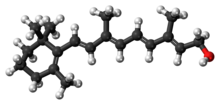Our website is made possible by displaying online advertisements to our visitors.
Please consider supporting us by disabling your ad blocker.
Retinol
 | |
 Retinol | |
| Clinical data | |
|---|---|
| AHFS/Drugs.com | Monograph |
| License data | |
| Routes of administration | By mouth, intramuscular[1] |
| Drug class | vitamin |
| ATC code | |
| Legal status | |
| Legal status |
|
| Identifiers | |
| |
| CAS Number |
|
| PubChem CID | |
| IUPHAR/BPS | |
| DrugBank | |
| ChemSpider | |
| UNII |
|
| KEGG | |
| ChEBI | |
| ChEMBL | |
| PDB ligand | |
| CompTox Dashboard (EPA) | |
| ECHA InfoCard | 100.000.621 |
| Chemical and physical data | |
| Formula | C20H30O |
| Molar mass | 286.459 g·mol−1 |
| 3D model (JSmol) | |
| Melting point | 62–64 °C (144–147 °F) |
| Boiling point | 137–138 °C (279–280 °F) (10−6 mm Hg) |
| Solubility in water | 0.000017[2] mg/mL (20 °C) |
| |
| |
Retinol, also called vitamin A1, is a fat-soluble vitamin in the vitamin A family that is found in food and used as a dietary supplement.[3] Retinol or other forms of vitamin A are needed for vision, cellular development, maintenance of skin and mucous membranes, immune function and reproductive development.[3] Dietary sources include fish, dairy products, and meat.[3] As a supplement it is used to treat and prevent vitamin A deficiency, especially that which results in xerophthalmia.[1] It is taken by mouth or by injection into a muscle.[1] As an ingredient in skin-care products, it is used to reduce wrinkles and other effects of skin aging.[4]
Retinol at normal doses is well tolerated.[1] High doses may cause enlargement of the liver, dry skin, and hypervitaminosis A.[1][5] High doses during pregnancy may harm the fetus.[1] The body converts retinol to retinal and retinoic acid, through which it acts.[3]
Retinol was discovered in 1909, isolated in 1931, and first made in 1947.[6][7] It is on the World Health Organization's List of Essential Medicines.[8] Retinol is available as a generic medication and over the counter.[1] In 2021, vitamin A was the 298th most commonly prescribed medication in the United States, with more than 500,000 prescriptions.[9][10]
- ^ a b c d e f g "Vitamin A". Drugs.com, The American Society of Health-System Pharmacists. 12 December 2024. Retrieved 10 September 2024.
- ^ Bonrath W, Gao B, Houston P, McClymont T, Müller MA, Schäfer C, et al. (September 2023). "75 Years of Vitamin A Production: A Historical and Scientific Overview of the Development of New Methodologies in Chemistry, Formulation, and Biotechnology". Organic Process Research & Development. 27 (9): 1557–84. doi:10.1021/acs.oprd.3c00161. ISSN 1083-6160.
- ^ a b c d Cite error: The named reference
odswas invoked but never defined (see the help page). - ^ Kong R, Cui Y, Fisher GJ, Wang X, Chen Y, Schneider LM, et al. (March 2016). "A comparative study of the effects of retinol and retinoic acid on histological, molecular, and clinical properties of human skin". Journal of Cosmetic Dermatology. 15 (1): 49–57. doi:10.1111/jocd.12193. PMID 26578346. S2CID 13391046.
- ^ British national formulary : BNF 69 (69 ed.). British Medical Association. 2015. p. 701. ISBN 9780857111562.
- ^ Squires VR (2011). The Role of Food, Agriculture, Forestry and Fisheries in Human Nutrition. Vol. IV. EOLSS Publications. p. 121. ISBN 9781848261952. Archived from the original on 5 November 2017.
- ^ Ullmann's Food and Feed, 3 Volume Set. John Wiley & Sons. 2016. p. Chapter 2. ISBN 9783527695522. Archived from the original on 5 November 2017.
- ^ World Health Organization (2023). The selection and use of essential medicines 2023: web annex A: World Health Organization model list of essential medicines: 23rd list (2023). Geneva: World Health Organization. hdl:10665/371090. WHO/MHP/HPS/EML/2023.02.
- ^ "The Top 300 of 2021". ClinCalc. Archived from the original on 15 January 2024. Retrieved 14 January 2024.
- ^ "Vitamin A - Drug Usage Statistics". ClinCalc. Retrieved 14 January 2024.
Previous Page Next Page


